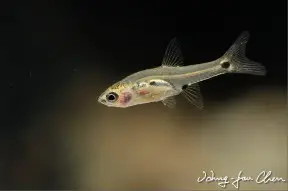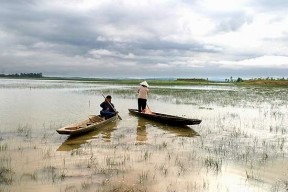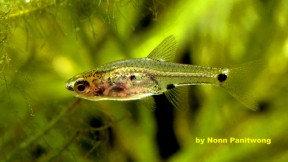Boraras micros
Etymology
Boraras: anagram of the generic name Rasbora, in reference to the reversed ratio of abdominal and caudal vertebrae in this genus.
micros: from the Ancient Greek μικρός (mikrós), meaning ‘small’, in reference to this species’ diminutive adult size.
Classification
Cyprinidae
Distribution
Mostly restricted to parts of the Mekong basin in northeastern Thailand where it’s been collected in the provinces of Nong Khai, Udon Thani and Sakon Nakhon. It’s also said to occur in Laos but we’ve been unable to obtain any definitive information.
Type locality is ‘Swamp 6 kilometers north of Udon Thani where road no. 2 crosses railway, Mekong basin, Udon Thani Province, 17°28″N, 102°48″E, Thailand’.
Habitat
Inhabits shallow bodies of water such as swamps, marshes, floodplains and rice paddies. Submerged vegetation tends to grow thickly in these predominantly clear waters and it is also known to move into temporarily inundated areas during the wet season.
Bung Khong Long is a lake and confirmed locality in Nong Khai province, Thailand. Aquatic plant species in the lake and surrounding floodplain include Hydrilla verticillata, Cerotophyllum dermersum, Chara zeylanica and Blyxa echinosperma. Salvinia cucullata is found floating on the surface and emergent plants comprise Eleocharis dulcis, Nelumbo nucifera, Lepironia articulata and Nymphaea lotus.
Other fishes include Brachygobius sp., Betta splendens, Betta smaragdina, Clupeichthys aesamensis, Odontobutis aurarmus, Kryptopterus bicirrhis, Clarias batrachus, Rasbosoma spilocerca and Pao leiurus although it should be noted that not all of these can be kept together in an aquarium and some are likely to be unavailable in the trade.
Another interesting habitat is an area of wetland called Kud Ting in Nong Khai where it lives sympatrically with Rasbora rubrodorsalis and Rasbosoma spilocerca, which was put forwards as a prospective Ramsar site in 2008 due to the diversity of species found there.
Maximum Standard Length
10 – 13 mm.
Aquarium SizeTop ↑
Though small it still needs space to swim and dominant males will form temporary territories when spawning so a group is best kept in a tank with base dimensions of at least 45 ∗ 30 cm.
Maintenance
Best kept in a densely-planted aquarium and is an excellent choice for the carefully-aquascaped set-up. The addition of some floating plants and driftwood roots or branches to diffuse the light entering the tank also seems to be appreciated and adds a more natural feel.
Filtration does not need to be particularly strong as it mostly hails from sluggish waters and may struggle if there is a fast current. Don’t introduce it to a biologically-immature aquarium as it can be susceptible to swings in water chemistry.
Water Conditions
Temperature: 20 – 28 °C
pH: 6.0 – 7.0
Hardness: 36 – 179 ppm
Diet
As with other Boraras species it is likely to be a micropredator feeding on small insects, worms, crustaceans and other zooplankton in nature. In the aquarium it will accept dried foods of a suitable size but should not be fed these exclusively. Daily meals of small live and frozen fare such as Daphnia, Artemia along with good quality flakes and granules will result in the best colouration and encourage the fish to come into breeding condition.
Behaviour and CompatibilityTop ↑
This species is very peaceful but does not make an ideal community fish due to its small size and rather timid nature. It will do best when maintained alone or with other diminutive species such as Microdevario, Sundadanio, Danionella, Eirmotus, Trigonostigma, pygmy Corydoras and small Loricariids such as Otocinclus.
It also makes an ideal companion for shy anabantoids such as Sphaerichthys, Parosphromenus or the more diminutive Betta species, and in a planted set-up can be housed alongside freshwater shrimp of the genera Caridina and Neocaridina.
It’s a schooling species by nature and really should be kept in a group of at least 8-10 specimens. Maintaining it in decent numbers will not only make the fish less nervous but will result in a more effective, natural-looking display. Males will also display some interesting behaviour as they compete with one other for female attention.
Sexual Dimorphism
Mature females are noticeably rounder-bellied and often a little larger than males.
Reproduction
May not have been bred in captivity although it should certainly be possible. Like many small cyprinids it’s an egg-scattering, continuous spawner that exhibits zero parental care, so when in good condition small numbers of eggs will be laid daily. In a well-furnished, mature aquarium it’s therefore possible that small numbers of fry may start to appear without intervention.
However if you want to increase the yield of fry a slightly more controlled approach is required and we suggest trying a method that has proved successful for other species in the genus. The adult group can still be conditioned together but one or more small, perhaps 10-15 litre, containers should also be arranged.
These should be very dimly lit with the base either left bare or covered with some kind of mesh of a large enough grade so that any eggs that fail to adhere to the plant can pass through but small enough so that the adults cannot reach them.
The widely available plastic ‘grass’-type matting can also be used and works very well. The water itself should be of pH 6.0-7.0, 5-10°H with a temperature towards the upper end of the range suggested above.
A decent-sized clump of Java moss or other fine-leaved plant should also be added filling perhaps half the available space. Filtration is not really necessary but you can use a small, air-powered sponge filter if you prefer.
Two or three pairs of well-conditioned adult fish should then be introduced to each container. It is wise to make the transfer slowly in order to avoid excessive levels of stress but if conditions are to their liking they should begin to spawn the following morning.
While this species certainly will eat its eggs it appears not to actively hunt for them as is the case with many small cyprinids. Once spawning has commenced it should continue on a daily basis.
The pair(s) should be left in situ for no more than a couple of days before being removed as the first eggs should hatch by the second day after the initial spawning. The tiny young will survive on their yolk sacs for another 24 hours or so after which they will require Paramecium or other microscopic food.
After a week to ten days they should be large enough to accept Artemia nauplii/microworm etc. As the days pass additional fry should start to appear from later spawning events. It’s best to wait a week or two before starting to perform small water changes in order to avoid unduly shocking the young fish.
NotesTop ↑
This species is poorly-documented and rarely seen in the trade, with many of the available images labelled with its name depicting more colourful congeners.
It’s actually difficult to confuse with any of its close relatives being a rather plainly-patterned fish and this may be partly the reason why it’s not more widely-available. Fish seen on sale as B. micros var. ‘red’ or ‘strawberry rasbora’ are always B. maculatus, B. brigittae or B. naevus.
Boraras was erected in 1993 in order to separate a small group of species from the larger Rasbora assemblage on the basis of differences in morphology and reproductive strategy.
In older literature they are therefore referred to as members of Rasbora and following Liao et al. (2010) the genus is a member of the rasborin sub-group within the subfamily Danioninae (the other sub-group contains the danionins).
This group is further subdivided into six clades (clusters of closely-related species) of which Boraras (or at least B. brigittae; the only species involved in the study) is included in ‘clade three’ alongside Horadandia atukorali, Rasboroides vaterifloris, Trigonostigma heteromorpha and three species previously included in Rasbora but moved into new genera by the authors; Trigonopoma gracile, T. pauciperforatum and Rasbosoma spilocerca.
Of these it was found to form a monophyletic group with Rasboroides meaning these two derived from the same common ancestor. The results for B. brigittae and T. heteromorpha were found to be inconclusive in some respects and further work regarding their phylogenetic position was recommended.
Shortly afterwards a paper investigating systematics of the subfamily Danioninae was published by Tang et al. (2010) Their results differed from those of Liao et al. and their conclusion was to synonymise the four new genera plus Boraras and Trigonostigma with Rasbora based on an incomplete knowledge of relationships within the group, an approach they describe as ‘more conservative’. This has not been followed by the majority of authors, however, and the separate groupings are maintained in the extensive work by Kottelat (2013), which is followed here.
The small adult size in Boraras species evolved via a process known as miniaturisation, characterised by sexually mature adults with a significantly reduced size of less than 20 mm SL.
Among bony fishes cyprinids are one of the few groups in which this phenomenon occurs repeatedly with all Barboides, Danionella, Microdevario, Microrasbora, Horadandia, Boraras, Paedocypris, Sawbwa and Sundadanio species representing miniaturised taxa along with a few members of Danio, Laubuca and Rasbora. All show a preference for still or slow-moving waters, often in nutrient-poor habitats such as forest peat swamps.
The anatomical structure of miniaturised cyprinids can vary greatly, and there are two principle ‘groupings’ with some species possessing intermediate features to some degree. The first contains those fishes which though small are essentially proportionally dwarfed versions of their larger relatives, e.g., Barboides, Microdevario, Microrasbora, Boraras, etc.
The other includes those in which anatomical development stops at a point where adult still resemble a larval form of their larger ancestor, i.e., Danionella and Paedocypris.
The latter are usually referred to as ‘developmentally truncated’ or ‘paedomorphic’ and are thought to have evolved via a process known as ‘progenetic paedomorphosis’ i.e. paedomorphosis brought about by accelerated maturation. They typically exhibit a simplified skeletal structure along with species-specific morphological peculiarities.
Britz et al. (2009) consider that developmental truncation may have facilitated the development of such novelties ‘by freeing large parts of the skeleton from developmental constraints, dissociating developmentally linked pathways and creating a greater potential for more dramatic changes’.
Boraras species from the Malay Archipelago (B. brigittae, B. maculatus and B. merah) tend to have a slimmer, more elongate body profile than those from Indochina (B. micros, B. urophthalmoides, B. naevus) which may assist when attempting to identify them.
References
- Kottelat, M. and C. Vidthayanon, 1993 - Ichthyological Exploration of Freshwaters 4(2): 161-176
Boraras micros, a new genus and species of minute freshwater fish from Thailand (Teleostei: Cyprinidae). - Conway, K. W., 2005 - Ichthyological Exploration of Freshwaters 16(3): 249-264
Monophyly of the genus Boraras (Teleostei: Cyprinidae). - Conway, K. W. and M. Kottelat, 2011 - Zootaxa 3002: 45-51
Boraras naevus, a new species of miniature and sexually dichromatic freshwater fish from peninsular Thailand (Ostariophysi: Cyprinidae). - Kottelat, M., 2013 - The Raffles Bulletin of Zoology Supplement 27: 1-663
The fishes of the inland waters of southeast Asia: a catalogue and core bibiography of the fishes known to occur in freshwaters, mangroves and estuaries. - Liao, T. Y., Kullander, S. O. and F. Fang, 2009 - Zoologica Scripta 39(2): 155-176
Phylogenetic analysis of the genus Rasbora (Teleostei: Cyprinidae). - Mayden, R. L., K. L. Tang, K. W. Conway, J. Freyhof, S. Chamberlain, M. Haskins, L. Schneider, M. Sudkamp, R. M. Wood, M. Agnew, A. Bufalino, Z. Sulaiman, M. Miya, K. Saitoh, and S. He, 2007 - Journal of Experimental Zoology, Molecular Development and Evolution 308B: 1–13
Phylogenetic relationships of Danio within the order Cypriniformes: a framework for comparative and evolutionary studies of a model species. - Tang, K. L., M. K. Agnew, W. J. Chen., M. V. Hirt, T. Sado, L. M. Schneider, J. Freyhof, Z. Sulaiman, E. Swartz, C. Vidthayanon, M. Miya, K. Saitoh, A. M. Simons, R. M. Wood and R. L. Mayden, 2010 - Molecular Phylogenetics and Evolution 57(1): 189-214
Systematics of the subfamily Danioninae (Teleostei: Cypriniformes: Cyprinidae).





